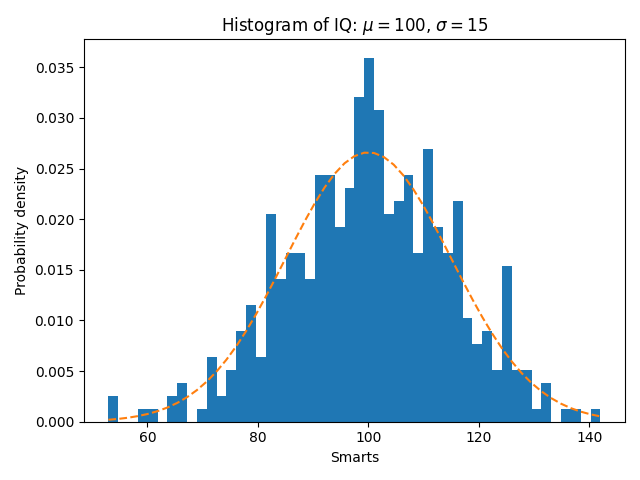ノート
完全なサンプルコードをダウンロードするには、ここをクリックしてください
ヒストグラム (hist) 関数のいくつかの機能#
基本的なヒストグラムに加えて、このデモではいくつかのオプション機能を示しています。
データビン数の設定。
ヒストグラムの積分が 1 になるようにビンの高さを正規化する密度パラメーター。結果のヒストグラムは、確率密度関数の近似値です。
異なるビン数とサイズを選択すると、ヒストグラムの形状に大きな影響を与える可能性があります。Astropy のドキュメントには、これらのパラメーターを選択する方法に関する優れたセクションがあります。
import numpy as np
import matplotlib.pyplot as plt
np.random.seed(19680801)
# example data
mu = 100 # mean of distribution
sigma = 15 # standard deviation of distribution
x = mu + sigma * np.random.randn(437)
num_bins = 50
fig, ax = plt.subplots()
# the histogram of the data
n, bins, patches = ax.hist(x, num_bins, density=True)
# add a 'best fit' line
y = ((1 / (np.sqrt(2 * np.pi) * sigma)) *
np.exp(-0.5 * (1 / sigma * (bins - mu))**2))
ax.plot(bins, y, '--')
ax.set_xlabel('Smarts')
ax.set_ylabel('Probability density')
ax.set_title(r'Histogram of IQ: $\mu=100$, $\sigma=15$')
# Tweak spacing to prevent clipping of ylabel
fig.tight_layout()
plt.show()

参考文献
この例では、次の関数、メソッド、クラス、およびモジュールの使用が示されています。